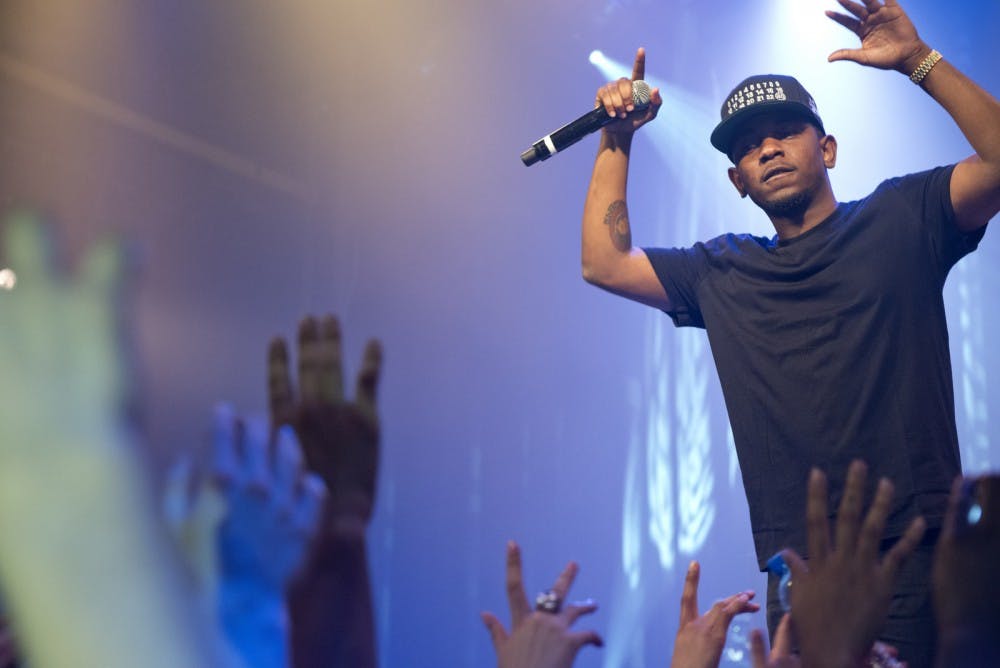There's no way to unpack a Kendrick Lamar LP in one listen. From his major breakthrough "good kid, m.A.A.d city," presented as a time-jumping short film, to his ambitious, eclectic follow-up "To Pimp a Butterfly" which garnered 11 Grammy nominations -- one short of Michael Jackson's record for "Thriller" -- a Lamar record is guaranteed to come loaded with multi-narrative character arcs, history-spanning musical cues and some of the most stunning vocal acrobatics in hip-hop. Even last year's comparably small TPAB companion piece "untitled unmastered." was among the best rap releases of the year.
It's no surprise that Kendrick is considered one of the greatest rappers of this decade. He's almost grown into something bigger than a music artist. The state of California named him a positive icon, and it's now common practice for people to analyze his every word and decision. The buzz surrounding the release of his fourth LP "DAMN." is a prime example of this radical fixation from audiences that are -- if we're being honest -- well outside of his intended demographic. Take, for instance, the wild conspiracy that, because Kendrick took a picture in front of both a red and a blue brick wall, he would be releasing two albums over Easter weekend.
And it goes beyond Internet theories. The amount of people I've seen sharing Word documents with song analyses and alternative track orders is incredible, bordering on ludicrous. But what's most unbelievable is that, somehow, "DAMN." manages to hold up against all expectations and examinations. Kendrick's lyricism and storytelling is what makes him special, and he never forgets it on this urgent, layered and complex masterpiece. While it takes multiple listens to pick apart the record's multifaceted themes, this also contains some of his most immediately effective, and affecting, tunes.
Even though it clocks in at 14 tracks and 55 minutes long, "DAMN." is the shortest and most streamlined Kendrick Lamar album yet. Gone is the West Coast 1990s revivalism of "good kid, m.A.A.d city" and the avant-garde jazz backdrops of "To Pimp a Butterfly." Lamar opts for tense, terse trap beats and trademark sounds from some of the best contemporary producers in the game; Mike WiLL Made-It supplies the hardest-hitting beats of Kendrick's discography on "DNA." and "HUMBLE.," the Internet's Steve Lacy wrote the lo-fi instrumentation for "PRIDE." and the magnificent James Blake puts his eccentric stamp on "ELEMENT." (The latter marks yet another huge collaboration for the British Blake, who also wrote tracks for Beyonce's "Lemonade" and Frank Ocean's "Blonde.")
While the producers are certainly instrumental (no pun intended) in creating "DAMN.'s" atmosphere, it's Kendrick's role as an unparalleled wordsmith that sets the album apart from its tough competition. Each track's one-word title, ending with a period, suggests focused conciseness. However, where a lesser rapper would spend a track called "LUST." talking about all the women in his life, Kendrick goes much deeper than that, using sexual metaphors to dissect how the desire for an inkling of fame can turn into a complete obsession as stardom slowly deteriorates your former self.
Kendrick has been exploring the harmful effects of fame for years. On the "good kid" track "Sing About Me, I'm Dying of Thirst," the Compton-born rapper pledges to dedicate his career to being a voice for the voiceless, spreading the word about those who died tragic deaths while society turned its gaze elsewhere. Having achieved that fame on "TPAB," he chronicles his struggle to stay connected to his city. He became successful enough to escape poverty; is it his mission to be the voice for those that are still stuck in the streets?
"DAMN." puts more emphasis on not only the pitfalls of stardom, but also its racial, societal and personal implications. The brilliant, epic "FEAR." chronicles the narrator's experience with the titular emotion at the ages of 7, 17 and 27, effortlessly switching between commentary on domestic abuse, gang violence and police brutality, and financial security. Meanwhile, "DNA." demonstrates pride identity while recognizing humanity's imperfections, and album closer "DUCKWORTH." is like a mini-biography of Top Dawg Entertainment CEO Anthony Tiffith, who discovered and signed Kendrick even though he almost killed his father years before.
The songs on this album find Kendrick examining and challenging his notions on everything from fate, coincidence, passion, religion and even race (he ends "ELEMENT." by saying, "Last LP I tried to lift the black artist/but it's a difference between black artists and whack artists"). To make it more impressive, he packages this philosophical turmoil in some surprisingly accessible songs, which undoubtedly helped the album score the biggest debut of the year, with 603,000 equivalent sales upon its first week of release. This was a remarkably genius move by Kendrick, capitalizing on the mounting buzz surrounding his role in the cultural zeitgeist and putting out his most popular release yet, while refusing to lose that sharp narrative edge that earns him such astounding acclaim. Damn, indeed.
(5/5 stars)




